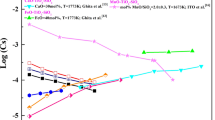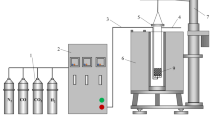Abstract
Japan started the national project “COURSE 50” for CO2 reduction in the 2000s. This project aimed to establish novel technologies to reduce CO2 emissions with partially utilization of hydrogen in blast furnace-based ironmaking by 30% by around 2030 and use it for practical applications by 2050. The idea is that instead of coke, hydrogen is used as the reducing agent, leading to lower fossil fuel consumption in the process. It has been reported that the reduction behavior of hematite, magnetite, calcium ferrite, and slag in the sinter is different, and it is also considerably influenced by the sinter morphology. This study aimed to investigate the reduction behavior of sinters in hydrogen enriched blast furnace with different mineral morphologies in CO—CO2—H2 mixed gas. As an experimental sample, two sinter samples with significantly different hematite and magnetite ratios were prepared to compare their reduction behaviors. The reduction of wustite to iron was carried out at 1000, 900, and 800°C in a CO—CO2—H2 atmosphere for the mineral morphology-controlled sinter, and the following findings were obtained. The reduction rate of smaller amount of FeO led to faster increase of the reduction rate curve at the initial stage of reduction. Macro-observations of reduced samples showed that the reaction proceeded from the outer periphery of the sample toward the inside, and a reaction interface was observed where reduced iron and wustite coexisted. Micro-observations revealed three layers, namely, wustite single phase in the center zone of the sample, iron single phase in the outer periphery zone of the sample, and iron oxide-derived wustite FeO and iron, or calcium ferrite-derived wustite ‘FeO’ and iron in the reaction interface zone. A two-interface unreacted core model was successfully applied for the kinetic analysis of the reduction reaction, and obtained temperature dependent expressions of the chemical reaction coefficients from each mineral phases.
Similar content being viewed by others
References
Greenhouse Gas Inventory Office of Japan and Ministry of the Environment, Japan, ed., National Greenhouse Gas Inventory Report of JAPAN 2022, Center for Global Environmental Research, Earth System Division, National Institute for Environmental Studies, Japan, 2022.
T. Miwa and H. Okuda, CO2 ultimate reduction in steelmaking process by innovative technology for cool earth 50 (COURSE50), J. Jpn. Inst. Eng., 89(2010), No. 1, p. 28.
S. Ban-Ya, Y. Iguchi, and T. Nagasaka, Rate of reduction of liquid wustite with hydrogen, Tetsu-to-Hagane, 70(1984), No. 14, p. 1689.
Y.B. Chen and H.B. Zuo, Review of hydrogen-rich ironmaking technology in blast furnace, Ironmaking Steelmaking, 48(2021), No. 6, p. 749.
K.H. Ma, J.Y. Deng, G. Wang, Q. Zhou, and J. Xu, Utilization and impacts of hydrogen in the ironmaking processes: A review from lab-scale basics to industrial practices, Int. J. Hydrogen Energy, 46(2021), No. 52, p. 26646.
Steel Year Book, Japan Metal Daily, Tokyo, 2014, p. 84.
Y.N. Qie, Q. Lyu, J.P. Li, C.C. Lan, and X.J. Liu, Effect of hydrogen addition on reduction kinetics of iron oxides in gas-injection BF, ISIJ Int., 57(2017), No. 3, p. 404.
T. Murakami, H. Wakabayashi, D. Maruoka, and E. Kasai, Effect of hydrogen concentration in reducing gas on the changes in mineral phases during reduction of iron ore sinter, ISIJ Int., 60(2020), No. 12, p. 2678.
K. Higuchi, S. Matsuzaki, K. Saito, and S. Nomura, Improvement in reduction behavior of sintered ores in a blast furnace through injection of reformed coke oven gas, ISIJ Int., 60(2020), No. 10, p. 2218.
T. Yagi and Y. Ono, A method of analysis for reduction of iron oxide in mixed-control kinetics, ISIJ Int., 8(1968), No. 6, p. 377.
M. Ishida and C.Y. Wen, Comparison of kinetic and diffusional models for solid-gas reactions, AIChE J., 14(1968), No. 2, p. 311.
T. Murayama and Y. Ono, Method of determination of parameters included in ISHIDA-WEN’S model, Tetsu-to-Hagane, 73(1987), No. 10, p. 1323.
J. Szekely and J.W. Evans, A structural model for gas—Solid reactions with a moving boundary, Chem. Eng. Sci., 25(1970), No. 6, p. 1091.
J. Szekely and J.W. Evans, A structural model for gas-solid reactions with a moving boundary-II: The effect of grain size, porosity and temperature on the reaction of porous pellets, Chem. Eng. Sci., 26(1971), No. 11, p. 1901.
D. Noguchi, K.I. Ohno, T. Maeda, K. Nishioka, and M. Shimizu, Kinetics of reduction step of wustite to iron of hematite and quaternary calcium ferrite mixtures, Tetsu-to-Hagane, 98(2012), No. 2, p. 55.
R.H. Spitzer, F.S. Manning, and W.O. Philbrook, Generalized model for the gaseous, topochemical reduction of porous hematite spheres, Trans. Metall. Soc. AIME, 236(1966), p. 1715.
W.E. Ranz and W.R. Marshall, Evaporation from drops, part I, Chem. Eng. Prog., 48(1952), No. 3, p. 141.
H.W. St. Clair, Rate of reduction of an oxide sphere in a stream of reducing gas, Trans. Metall. Soc. AIME, 233(1965), p. 1145.
T. Usui, M. Naito, T. Murayama, and Z.I. Morita, Kinetic analysis on gaseous reduction of agglomerates, part 1, reaction models for gaseous reduction of agglomerates, Tetsu-to-Hagane, 80(1994), No. 6, p. 431.
T. Maeda and Y. Ono, Kinetics of reduction step of wustite to iron in gaseous reduction of quaternary calcium ferrite, Tetsu-to-Hagane, 77(1991), No. 10, p. 1569.
T. Murayama, Y. Ono, and C. Kamijo, Effect of the amount of gangue on rate parameters included in the unreacted-core model, CAMP-ISIJ, 2(1989), No. 4, p. 949.
Acknowledgement
This paper is based on results obtained from the “CO2 Ultimate Reduction System for Cool Earth 50 (COURSE50) Project” commissioned by the New Energy and Industrial Technology Development Organization (NEDO).
Author information
Authors and Affiliations
Corresponding author
Additional information
Conflict of Interest
The authors declare no conflict of interests.
Rights and permissions
About this article
Cite this article
Ohno, Ki., Maeda, T., Kunitomo, K. et al. Effect of FeO concentration in sinter iron ore on reduction behavior in a hydrogen-enriched blast furnace. Int J Miner Metall Mater 29, 1820–1829 (2022). https://doi.org/10.1007/s12613-022-2480-x
Received:
Revised:
Accepted:
Published:
Issue Date:
DOI: https://doi.org/10.1007/s12613-022-2480-x




